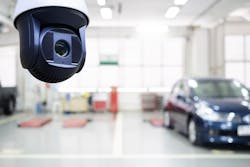6 security tips every auto repair shop should follow
"I can't find the new shop scan tool."
Hopefully, this isn't a statement you've heard in your shop, especially after making the final payment on a $9,000 investment in your business. What's worse is hearing the question, "Where's the red convertible it took us three days to finish?" These stressful situations will immediately make you reflect on and ask: "What steps could we have taken to avoid that punch-in-your-gut feeling you have right now, and who is in charge of regularly checking valuable shop equipment and monitoring the building's security as a whole?"
Many shop owners have SOPs (Standard Operating Procedures) to ensure consistency, quality, and more favorable outcomes. Some examples are how we speak to customers over the phone, perform courtesy checks on cars, and pay vendor invoices, among other things, but how many of those same shops have security SOPs in place to protect their shop? For an owner and manager of multiple auto shops, security SOPs should be equally important and are at the top of my priority task list.
Walk the property
There are many things to consider, whether you've been at a location for multiple years or are stepping through the door for the first time, and there is a lot you can learn from simply "walking" the property. External lights may be out, trash or scrap metal areas are unsecured, long-term or abandoned cars on the property, or doors and locks in poor condition, to name a few. Listing all the possible shortcomings both inside and outside your business and then attending to them in the appropriate order and time frame will prevent avoidable losses.
Know your team
Whether you are a short or long-term manager at your shop, how you pursue problems related to personnel will significantly impact keeping the business secure. If you're the new guy, you will want to know who has keys to access the building, if any sets of keys are missing, and if any former employees were let go due to harm to the business or the people who work there. That, in turn, would require the question: Is changing the locks necessary? Whether you know about schemes that already transpired or are aware of vulnerable issues resulting from a blind eye, these are scenarios you need to tackle.
Upgrade your security system
What about technology? You would be drastically behind the times if you didn't have a comprehensive security system accompanied by cloud-based cameras installed in your business. The alarm access should have the same scrutiny as the key holders. Who has code access? Are all personnel with security access using different codes?
Using a unique code for each employee is imperative and enables you to track each individual's enter and exit times when the time calls for it. If a third party monitors the building, who gets the call in the event of an after-hours problem?
Ensure all cameras, motion sensors, and any other electronics related to the security system are in good working order as designed. Ensure those same cameras and sensors accurately cover all designated areas appropriately and don't create a "dead spot" that leaves you vulnerable to any malice.
Schedule security inspections
Close inspections can reveal breaks in your security program. Consider things like doors whose hinges have worn out, causing a crooked mating surface, but at the time, your solution was to have the lowest-paid employee rig it to get it to shut. What you looked past is now the alarm contact sensor at the top has intermittent connection issues.
Continue your external inspection, and you might find a bay door that closes crooked, leaving a gap for cold air or rodents to creep in. Maybe it's just enough of a gap to allow for a low-profile floor jack to slide underneath, pry the door open more, and enable a person to enter the building. When the sun is out for long stretches of the day during the summer, random parking lot lights that had gone out went unnoticed, but now, on the coldest day in mid-winter, you are in the parking lot at 6:30 p.m. dealing with a customer's vandalized car in the area the light was supposed to illuminate. Since no one ever did an inspection, it created a blind spot for vandals to break into the customer's car and cause damage and steal property.
We could have prevented all of this if we scheduled an inspection of our security tools and processes. The difference now is the walk has a purpose behind it, and it surprises you with the inspection results.
Protect company assets
Moving inside to protect company assets, what opportunities will we find? Do you have a cash SOP in place? Is your cash drawer always locked during business hours with only the employees you deem fit in possession of a key? Do deposits get made nightly and, if so, is it safe for the person carrying that deposit to go to the bank at that specific time?
The better solution would be to make deposits during the day, if necessary, which means storing the deposit in a properly anchored safe overnight. While at the safe, make sure the customer and shop vehicle keys are locked up after those vehicles are pulled inside for the night, which leads to a perfect transition to another SOP — closing procedures.
As safe as you may think the community you work in is, you are susceptible to unwanted property damage, and theft claims if you had the room to bring vehicles into your shop but knowingly left them outside. That does not include the possibility that mother nature might want to blow your dumpster out of its designated area or rest a tree in your parking lot. It is up to you if the tree lands on the ground or on the hood of a customer's car.
When you do bring those cars in, do a nightly "walk." At the end of business each day, make sure someone you deem highly responsible is checking that doors are correctly shut and latched. This is even more important leading up to a holiday, or any other occasion that will make for a longer-than-normal stretch when personnel won't be entering again for a few days.
And finally, guard against the biggest threat…
Up to this point, we focused on property, products, and procedures that can help your company stay secure, but the biggest risk you have of losing property and assets is due to disgruntled employees. We encourage all of our staff to take an engagement survey each year to keep our staff highly motivated and engaged and give us some insight into possibly disengaged employees. We must manage people and maintain vital processes when handling cash, inventory, and company assets. A disgruntled employee left unchecked can take a company for thousands of dollars before someone raises the first suspicion.
We have all heard the story of how management trusted an employee and never thought they would take advantage of them or the company only to find out differently. My dad would always say to me, "We put locks on the doors to keep the honest people honest." What he was telling me is a lock is not going to stop someone who really wants inside. The lock is a reminder for honest people who have a dishonest thought for a fleeting second.
As owners and managers who want to run a successful and growing business, employ the best technicians and maximize customer satisfaction. You will have an upward trend in business and serve the community. It would be a shame to work so hard every day for each sales dollar, only for it to disappear out the back or unlocked door.
About the Author

Koole Bolina
Koole Bolina has been in the automotive industry since 1998, starting with a personal interest in automotive repairs, and he continues to be part of car clubs, drag racing, and keeping up with industry trends. Koole's strong points are long-term retainment of valuable employees, high customer feedback scores, and maintaining a safe working environment—all while exceeding revenue and profit goals. These achievements were possible by making decisions, and changes on a shop-specific basis and not a "one size fits all" approach. ATI's 33 full-time, certified coaches, including Koole, have helped ATI's members earn over TWO BILLION DOLLARS in return on their coaching investment since ATI was founded.
